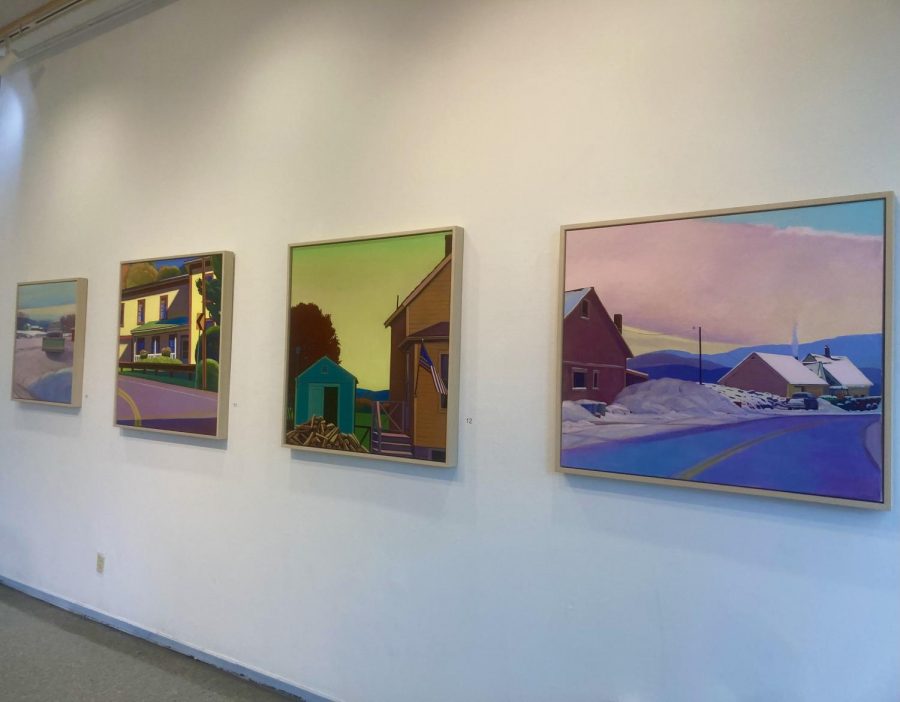Abbot’s populated landscapes
A few of Abbot’s works on display
The Julian Scott Memorial Gallery, located within the Dibden Center for Fine Arts, is NVU-Johnson’s epicenter for artistic display. For the latter half of each semester, fine arts students display their work in the gallery; however, for the first half of the semester, the gallery is used as a place for non-student artists to present their work.
Following the industrial sculptural display of Matt Neckers earlier this semester, the gallery has shifted to a showing of landscape paintings by artist Susan Abbott. Abbott is originally from the suburbs of DC but moved to Vermont 27 years ago.
During her artist talk in the gallery, Abbott went into detail about the meaning of the paintings and her inspiration for creating them.
“My earliest memories really have to do with not so much what places look like, but the feeling that I got from those places,” Abbott said. “The empty lot next to my house or the stream that ran behind my house. They’re good feelings that came out of those places.”
Most of Abbott’s previous works depict scenery and emphasize color choices, and they do not often include people. Her work ranges from wintery scenes like “Road and Farm, Sunrise,” to winding roads at golden hour like “Turn in the Road.”
Abbott explains in her artist statement that she finds most inspiration in the Japanese concept of “wabi-sabi,” which she describes as, “embracing the aged, the imperfect, the modest, the natural, the seasonal, the private, the ambiguous.” Abbott said that New England is overflowing with this type of architecture and atmosphere.
“When I moved to Vermont, I suddenly felt like I’d come home,” Abbott said. “I think a lot of you that moved here, or found yourself kind of drifting here, had a sense of coming home when you came here. I think part of that is that Vermont, and really New England, is the childhood of the United States.”
Much like Necker’s sculptures, Abbott’s work is intended to have a whimsical appeal. Conversely, her paintings have a softer presence than the metallic sculptures that occupied the gallery before them.
Although Abbott is currently displaying a variety of her older paintings in the gallery, she is also premiering a new group of paintings for the first time; the collection is titled “In Place.”
The collection consists of 25 total watercolor pieces and several larger oil paintings. Each painting depicts scenes of blurry figures in everyday landscapes.
“It’s oftentimes that an idea will come to you in a really backhanded way,” said Abbott, “and what one has to learn is to pay attention to that. If you dismiss those ideas and say, ‘that’s stupid’ or ‘that’s not going to interest anybody,’ you’ve really lost your way in the creative fields, because that’s all you got.
“James, my husband, was cleaning out his office and found an old photo album from his family,” she continued. “It was tiny little photographs, most of them shot in the 30’s, 40’s and 50’s, so they were very small, black and white, and blurry.
“What struck me about them were a couple things. One was just the way the figures sat in the landscape, because I had been doing these kind of unpopulated landscape paintings where trucks and wood piles and windows are stand in for the people that populate these landscapes. But here were people populating the landscapes.”
The largest oil painting displayed from the collection, titled “Schoolgirls,” features a line of girls in solid-colored dresses on a golf course. The figures are blurry, much like the rest of the pieces. However, she said this painting was the only one not based on the family photos.
“I just was looking on the internet at photos from the 30’s and happened to see a tiny little black and white photo of these girls. I know nothing about the context of it whatsoever, but I found it intriguing, just the repetition of figures and the weirdness of it.”
Beneath the figures of this painting, as well as some of the others in the collection, are very jagged shadows. This became a topic for discussion during Abbot’s artist talk.
“I often will invent shadows for compositional reasons,” said Abbott. “These shadows were all invented as a way to kind of unify shapes, create more in the foreground. And in terms of the triangle part, it is true is that for me they created a kind of underlying tension.”
Abbot’s art will be on display in the Julian Scott Memorial Gallery until October 29. All students, faculty and visitors are invited to come look at the pieces. All 20 of the artworks currently being displayed in the Julian Scott Memorial Gallery are for sale. The full list of titles and prices is available at the gallery.

First year student from Orlando, FL.
Working on her second bachelors.
Love poetry, anime, and her dog (mostly her dog).
Dreams of living in a van.



